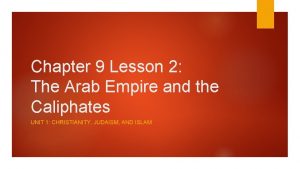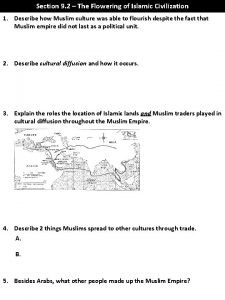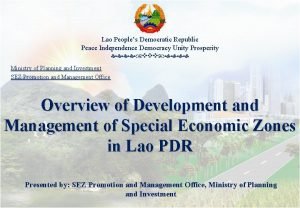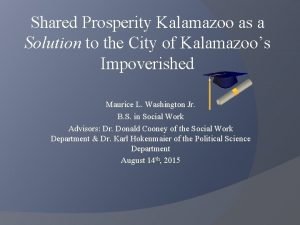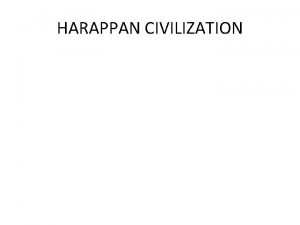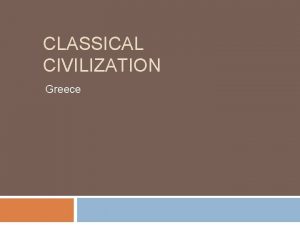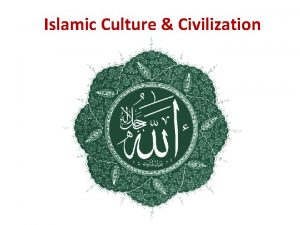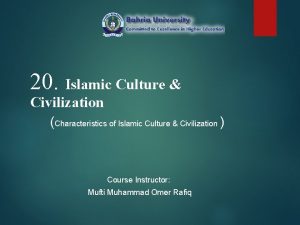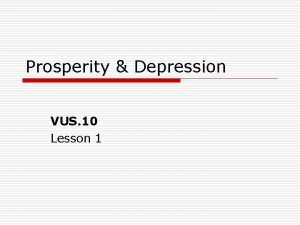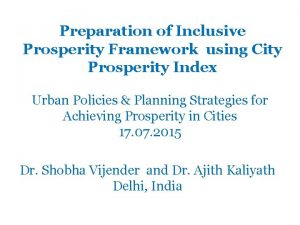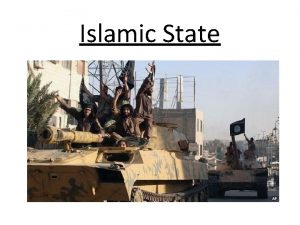Islamic Civilization Prosperity in the Islamic World Guiding













- Slides: 13

Islamic Civilization

Prosperity in the Islamic World Guiding Question: What factors allowed both urban and rural areas to flourish after the eighth century within the Arab Empire?

• one of the most prosperous periods in the history of the Middle East. • Arabs carried on extensive trade both by ship and by camel caravans (Africa, gold and ivory; and from Southeast Asia and India, sandalwood and spices. ) (Within the empire, Egypt contributed grain; Iraq provided linens, dates, and precious stones; and western India supplied textiles. ) • development of banking and the use of coins made it easier to exchange goods.

• With flourishing trade came prosperous cities. • At the tail end of the Arab Empire, Baghdad, the capital known as the City of Peace, was probably the greatest city in the empire and one of the greatest cities in the world. • the focus of trade shifted to Cairo (Egypt). • Damascus in modern-day Syria. Baghdad, Cairo, and Damascus were the centers of cultural, administrative, and economic activity for their regions.

City Appearance Islamic cities had/have a distinctive physical appearance. • palaces for caliphs or local governors and the great mosques for worship. • also public buildings with fountains and secluded courtyards, public baths, and bazaars, or marketplaces.

• • • bazaar, or covered market a crucial part of every Muslim city or town. important trading center, where goods from all the known world were for sale. Customers could compare prices and seek the best bargains. To make sure of high standards, bazaars had market inspectors who enforced rules. The bazaar also housed many craftspeople's shops • services like laundries and bathhouses. The Arab Empire was more urbanized than most other areas of the known world at the time. • However • a majority of people still lived in the country, making their living by farming or herding animals. • During the early stages of the empire, most of the farmland was owned by independent peasants. • Later, wealthy landowners began to amass large estates. • Some lands were owned by the state or the court and were farmed by slave labor.

Social Structure According to Islam, all Muslim people are equal in the eyes of Allah. • was not translated into social reality. • fairly well-defined upper class that consisted of ruling families, senior officials, nomadic elites, and the wealthiest merchants. Non-Muslims were not considered equal to Muslims in the Islamic world. • Slaves were one of the non-Muslim groups. • slavery was widespread. • most of their slaves came from Africa or from non-Islamic populations elsewhere in Asia. • Many had been captured in war. • Slaves often served in the army. • Many military slaves were freed. • Some even came to exercise considerable power. • women, were used as domestic servants. Islamic law made it clear that slaves should be treated fairly, and it was considered a good act to free them.

The Role of Women The Quran granted women spiritual and social equality with men. • men and women, were to be friends and protectors of one another. • Women had the right to the fruits of their work and to own and inherit property. However - Islamic teachings accounted for differences between men and women in the family and social order. • Both had duties and responsibilities. • men were dominant in Muslim society. (male-oriented society)

1. Every woman had a male guardian (father, brother, or other male relative) 2. Parents or guardians arranged marriages for their children. 3. Quran allowed Muslim men to have more than one wife, but no more than four • dowry (a gift of money or property) to their brides. 4. had the right of divorce under some circumstances. 5. Adultery was forbidden to both men and women. These rights of women begin to erode.

• After the spread of Islam, older customs eroded the rights enjoyed by early Muslim women. • some women were secluded and kept from social contacts with males outside their families. • The custom of requiring women to cover virtually all parts of their bodies when appearing in public was common in the cities and is still practiced today in many Islamic societies. Important to note - that these customs owed more to traditional Arab practice than to the Quran.

Philosophy, Science, and History Islamic civilization contributed more intellectually to the West than translations. • When Aristotle’s works arrived in Europe in the second half of the twelfth century, they were accompanied by commentaries written by outstanding Arabic philosophers • Islamic scholars also made contributions to mathematics and the natural sciences that were passed on to the West. • The Muslims adopted and passed on the numerical system of India, including the use of the zero. • A ninth-century Arab mathematician developed the mathematical discipline of algebra, which is taught in schools today. • Muslims set up an observatory at Baghdad to study the position of the stars. • knew that Earth was round, and they named many stars. • astrolabe, an instrument used by sailors to determine their location. (US History) • Huge with medicine – proved that disease could spread through water.

Literature, Art, and Architecture • Muslims regarded the Quran as their greatest literary work • Islamic art is a blend of Arab, Turkish, and Persian traditions. • Most decorations on Islamic art consisted of Arabic letters, natural plants, and abstract figures. • The best expression of Islamic architecture is found in the way Muslim mosques represent the spirit of Islam Minaret - the tower of a mosque from which the muezzin calls the faithful to prayer five times a day

Homework – Due next class 1: Why was the bazaar and important part of any Muslim city or town? 2: How was the social class divided throughout Muslim cities? 3: Name three contributions of Islamic scholars.
 Chapter 9 lesson 2 the arab empire and the caliphates
Chapter 9 lesson 2 the arab empire and the caliphates The flowering of islamic civilization
The flowering of islamic civilization Prosperity and depression worksheet answers
Prosperity and depression worksheet answers Prosperity oil
Prosperity oil Impressionism apush
Impressionism apush Peace independence democracy unity prosperity
Peace independence democracy unity prosperity Basic human aspirations are
Basic human aspirations are The growth of industrial prosperity
The growth of industrial prosperity Shared prosperity kalamazoo
Shared prosperity kalamazoo Populist cartoons
Populist cartoons The growth of industrial prosperity lesson 1
The growth of industrial prosperity lesson 1 Prosperity deals
Prosperity deals The four laws of debt free prosperity
The four laws of debt free prosperity Simplicity is prosperity
Simplicity is prosperity
